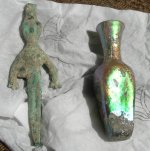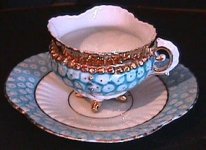SteveM
Well-known member
- Joined
- Jan 29, 2007
- Messages
- 1,928
These Roman or perhaps even pre-Roman artifacts were found in the vineyards of a Bekaa Valley (Lebanon) wine producer we met a number of years ago.
The glass is a lachrymatory bottle (tear vial), and according to someone supposedly 'in the know', the glittering surface is ground pearls (nacre), or pearl dust. I've just begun my research on this, pearl dust coming up as an additive to cake frostings (for metallic lustre) or in the case of real pearls, as a dietary 'supplement' (Mikimoto famously consumed a pearl a day, and Cleopatra desolved a huge one in a glass of wine).
Perhaps there are forum readers who can already enlighten us on this application of our beloved subject?
Steve
Seattle
The glass is a lachrymatory bottle (tear vial), and according to someone supposedly 'in the know', the glittering surface is ground pearls (nacre), or pearl dust. I've just begun my research on this, pearl dust coming up as an additive to cake frostings (for metallic lustre) or in the case of real pearls, as a dietary 'supplement' (Mikimoto famously consumed a pearl a day, and Cleopatra desolved a huge one in a glass of wine).
Perhaps there are forum readers who can already enlighten us on this application of our beloved subject?
Steve
Seattle
Attachments
Last edited:



